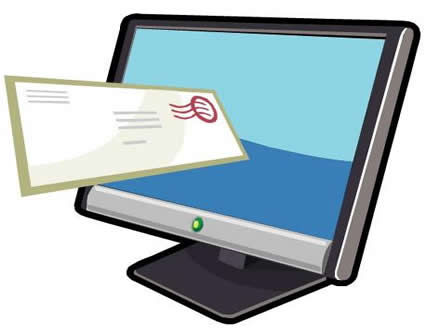神秘内容 Loading...
 (来源:英语杂志 http://www.EnglishCN.com) (来源:英语杂志 http://www.EnglishCN.com)
One day last fall, my colleague Miguel Morales received an email with a sign-off that was so strange, it has stuck in his mind for the last year. It came from Melissa Geisler, who works in digital sports programming and production at Yahoo. Below Geisler’s title and above her cell phone number was this mystifying quote: “The Bird is equal to or greater than the Word,” attributed to someone named, simply, “scientist.”
去年秋天某一天,我的同时Miguel Morales收到了一封结尾很奇怪的邮件,这个结尾去年一直让他反感。这封邮件是Melissa Geisler发的,她在雅虎从事数字体育节目制作的工作。在Geisler的职位下面,电话号码上面有这样一句奇怪的引言:“鸟可能大于或等于那个词”引自一个简单的名字自称为“科学家”的人。
With this and other strange sign-offs in mind, Miguel suggested I tackle the subject of how best to conclude an email. I polled colleagues, friends and four people I’d consider experts, including Cynthia Lett, 55, a business etiquette consultant in Silver Spring, MD. Below is their combined wisdom and some commentary of my own. I offer four rules and a long list of potential sign-offs.
对于这样子的和其它的一些结尾很奇怪的邮件,Miguel 建议我着手处理一篇主题为如何最好的结束一封邮件的文章。我对同事,朋友和我认为是专家的四个人进行调查,包括Cynthia Lett,他55岁,在马里兰州银泉做商业礼仪顾问,然后总结出如下凝聚他们智慧和我自己补充的结尾语。
But first, Geisler’s quote. She says it came from an episode of the animated cable TV show Family Guy, about a song from the 1960s. “That was me trying to have a little fun,” she says, adding that she has since changed her signature to add Yahoo’s new logo, and abandoning the quote, which she hoped recipients enjoyed while it lasted. Much as I respect Geisler’s attempt at levity, I think it’s a mistake to leave people guessing about what you want to say.
但是首先着手的是Geisler的引言。她说那句引言出自于动画片恶搞之家,是关于二十世纪六十年代的一首歌曲。她说“我只是想找些乐子,”,她还说她已经删掉了那个引言,将结尾改成了雅虎的新标识,她希望收件人能够喜欢。我认为Geisler的这种尝试是有点轻率的,让别人去猜测你在邮件中真正想要表达什么是不妥当的。
Here are my four rules for signing off on emails:
下面是我总结出来的邮件结尾的四个规则:
1.Don’t include quotes.
1.不要包含引言。
2. Avoid oversized corporate logos. Sometimes we have no choice about this, because our companies insist we include these things, but if they are too big, they draw the eye away from the message.
2.避免过大的公司标识。有时候我们别无选择,因为公司坚持让我们使用这些东西,但是如果标识太大了,它会分散看信息的注意力。
3. Include your title and contact info, but keep it short. In most business emails, you’re doing the person a favor by sharing your vital information. But make it minimal. Mine just says, “Susan Adams, Senior Editor, Forbes 212-206-5571.” A short link to your website is fine but avoid a laundry list of links promoting your projects and publications.
3.包含你的职位和联系信息,但是保持简洁。对于大多数商业邮件,分享重要信息是在帮助别人。但是保持简短。像我的就写,“Susan Adams,福布斯杂志高级编辑,212-206-5571。”包含你公司网站的短链接是可以接受的,但是避免出现一系列推广你的项目和出版物的链接。
4. Do include some kind of sign-off. Mark Hurst, 40, author of Bit Literacy: Productivity in the Age of Information and E-mail Overload, says the function of a sign-off is to signal the end of a message, so the recipient knows it didn’t get short-circuited. “To me the sign-off is not so much style as function in the service of clearly communicating your message,” he says.
4.务必包含结尾。Mark Hurst,40岁,比特素养的作者说:在信息和邮件超载的时代,结尾的功能是标志邮件的结束,因此收件人知道没有短路。他说,“对于我来说,结尾作为清晰地传达信息的工具没有太多的格式。”
Etiquette consultant Lett advocates a more formal approach. “I don’t believe emails are conversations,” she says. “They’re letters.” I disagree. Emails are their own form of communication and they’re evolving fast. Farhad Manjoo, 35, Wall Street Journal technology columnist and until recently, the voice behind a Slate podcast, “Manners for the Digital Age,” puts it well: “An email is both a letter and an instant message,” he observes.
礼仪顾问Lett提倡一个更加正式的方法。他说“我不认为邮件是对话,他们是信件。” 我不同意。邮件是他们彼此交流的形式,并且他们迅速发展。Farhad Manjoo,35岁,华尔街日报技术专栏作家,最近在Slate播客“数字时代的礼仪”中说的好,“邮件既是信件也是即时消息。”
All of that said, here is a list of common and not-so-common email sign-offs, with commentary and notes from the experts.
尽管如此,下面是一些带有专家评论和注释的常见的和不那么常见的邮件结尾。
|

